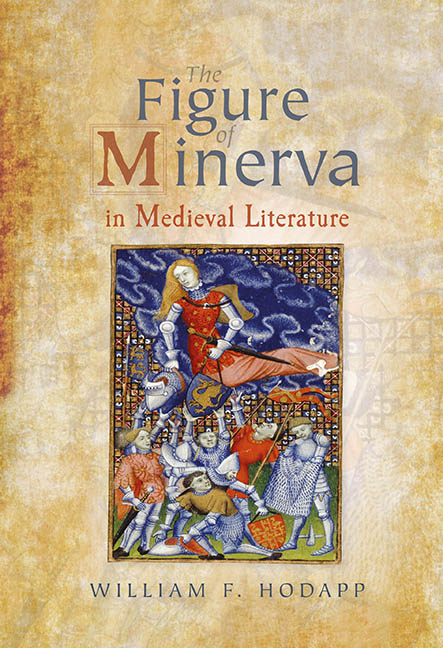Book contents
- Frontmatter
- Dedication
- Contents
- Illustrations
- Acknowledgements
- Abbreviations
- Introduction
- 1 The Roman Minerva and Elements of Medieval Classicism
- 2 The Sapiential Tradition: Minerva as Redemptress
- 3 The Martianus Tradition: Minerva as Mistress of the Liberal Arts
- 4 The Patrona Tradition: Minerva as Protectress and Benefactor
- 5 The Patristic Tradition: Minerva as Idol
- 6 The Ovidian Tradition: Minerva as Venus’ Ally
- Conclusion
- Bibliography
- Index
1 - The Roman Minerva and Elements of Medieval Classicism
Published online by Cambridge University Press: 17 October 2019
- Frontmatter
- Dedication
- Contents
- Illustrations
- Acknowledgements
- Abbreviations
- Introduction
- 1 The Roman Minerva and Elements of Medieval Classicism
- 2 The Sapiential Tradition: Minerva as Redemptress
- 3 The Martianus Tradition: Minerva as Mistress of the Liberal Arts
- 4 The Patrona Tradition: Minerva as Protectress and Benefactor
- 5 The Patristic Tradition: Minerva as Idol
- 6 The Ovidian Tradition: Minerva as Venus’ Ally
- Conclusion
- Bibliography
- Index
Summary
Medieval poets, like those of any other period, did not work in a vacuum, creating verse ex nihilo. Rather, as Bonaventure (1221–74) observes about authorship in general, these poets drew on a wide range of available texts for images, ideas, modes, and genres. Reading as much as experience, or rather reading as experience as Mary Carruthers argues, contributed greatly to their writing. At times, this intertextual process is clear, as when Geoffrey Chaucer (c.1340–c.1400) begins The Book of the Duchess reading Ovid's tale of Ceyx and Alcione or recounts Virgil's Aeneid in Book 1 of The House of Fame; at others, it is not, as when he integrates his translation of Petrarch's Sonnet 132 into Troilus and Criseyde. Shot through with allusions, echoes, paraphrases, ideas, and images from other texts, medieval poetry reminds us much of medieval culture itself was largely, to borrow a phrase from Martin Irvine, a textual culture.
A dynamic interaction between reading and writing marks this culture, but the intertextual process does not simply end with a text newly composed. As has been long acknowledged, the concept of art for art's sake was foreign to medieval aesthetic sensibility. Medieval poets and artists worked with a sense of audience and a desire to engage them in an interactive experience of perception and interpretation through their art. If we take Chaucer, again, as example, and attend for a moment to the prologues of his early dream poems, we catch glimpses into his poetry workshop and hints of his poetic method. Chaucer reads a text (or several), offers a reading by rewriting it, then expands on it, producing another text to be read by his audience. The audience's act of reading, too, was dynamic: a social practice typically involving the ear as much as the eye. Readers often read aloud either to others in a group, as depicted in the famous “Troilus Frontispiece” in which Chaucer himself reads Troilus and Criseyde to courtly auditors who simultaneously “read” the poem through their ears (Fig. 1), or to oneself sotto voce, but nevertheless aloud. This dynamic of reading, writing, reading, as described by Joyce Coleman, invites the audience to become grammarians and interpret the poem, thereby offering them an opportunity to compose yet another text.
- Type
- Chapter
- Information
- The Figure of Minerva in Medieval Literature , pp. 11 - 43Publisher: Boydell & BrewerPrint publication year: 2019



